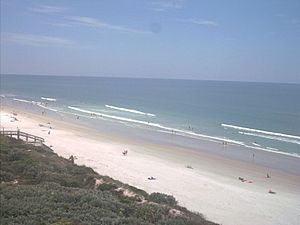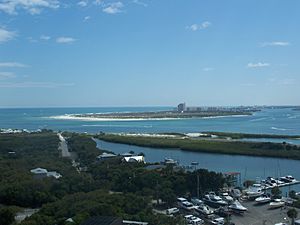New Smyrna Beach, Florida facts for kids
Quick facts for kids
New Smyrna Beach, Florida
|
|
|---|---|
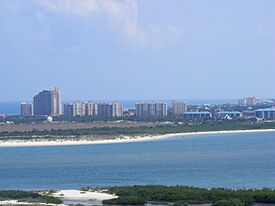
New Smyrna Beach from observation deck on top of Ponce de León Inlet Light
|
|
| Nickname(s):
"Florida's Secret Pearl"
|
|
| Motto(s):
Cygnus Inter Anates (Swan among Ducks)
|
|
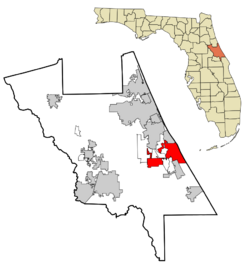
Location of New Smyrna Beach in Volusia County, Florida.
|
|
| Country | United States |
| State | Florida |
| County | Volusia |
| Settled (New Smyrna) |
1768 |
| Incorporated (town) (New Smyrna) |
1887 |
| Incorporated (city) (New Smyrna Beach) |
1947 |
| Government | |
| • Type | Commission–Manager |
| Area | |
| • City | 41.349 sq mi (107.093 km2) |
| • Land | 37.842 sq mi (98.011 km2) |
| • Water | 3.507 sq mi (9.083 km2) |
| Elevation | 7 ft (2 m) |
| Population
(2020)
|
|
| • City | 30,142 |
| • Estimate
(2023)
|
32,655 |
| • Density | 863.0/sq mi (333.2/km2) |
| • Urban | 402,126 (US: 104th) |
| • Metro | 721,796 (US: 83rd) |
| Time zone | UTC−5 (Eastern (EST)) |
| • Summer (DST) | UTC−4 (EDT) |
| ZIP Codes |
32168, 32169, 32170
|
| Area code(s) | 386 |
| FIPS code | 12-48625 |
| GNIS feature ID | 0287692 |
| Sales tax | 6.5% |
New Smyrna Beach is a city in Volusia County, Florida, United States. It is located on the central east coast of Florida, right by the Atlantic Ocean. The main part of the city is on the west side of the Indian River and the Indian River Lagoon. A bridge called the Coronado Beach Bridge connects the mainland to the beach on a coastal island.
In 2020, about 30,142 people lived here. By 2023, the population was estimated to be around 32,655.
The area is great for outdoor activities like fishing, sailing, golfing, and hiking. Many visitors enjoy water sports such as swimming, scuba diving, and surfing. In 2009, Surfer ranked New Smyrna Beach as one of the "best surf towns." National Geographic also called it one of the "world's top 20 surf towns" in 2012. It's also known as "The Shark Bite Capital of the World."
New Smyrna Beach's motto is cygnus inter anates, which is a Latin phrase meaning "a swan among ducks." The city is part of Florida's "Fun Coast" region. This name was created by the Daytona Beach/Halifax area Chamber of Commerce. It matches the local area code 386, which spells FUN on a phone keypad!
Contents
History of New Smyrna Beach
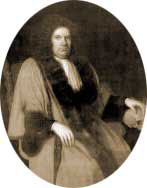
Europeans first settled in this area in 1768. A Scottish doctor named Andrew Turnbull started a colony called New Smyrna. He named it after his wife's hometown, Smyrna (now İzmir in Turkey), which was also where some of his workers came from. Turnbull wanted to settle many people at once in North America, which was a big challenge.
Dr. Turnbull brought about 1,300 settlers to grow crops like hemp, sugarcane, and indigo. Most of these colonists came from Menorca, an island in Spain, and spoke Catalan. About 500 others came from the Mani peninsula in Greece.
The colony produced a lot of indigo at first. However, it faced many problems like diseases spread by insects and attacks from Native Americans. The colonists were also treated poorly by Turnbull and his managers. Eventually, the colony failed. The 600 survivors walked almost 70 miles north to St. Augustine, where their families still live today. In 1783, Florida was returned to Spain, and Turnbull left his colony.
The St. Photios Greek Orthodox National Shrine in St. Augustine honors the Greek settlers from New Smyrna. They were the first followers of the Greek Orthodox faith in North America. The museum there tells their story and how they helped build the city.
Central Florida had very few white settlers for a long time in the 1800s. Seminole Indians often raided the area to protect their land. The United States military fought against them in the Seminole Wars, but the Seminoles were never fully removed.
During the Civil War, in 1862, soldiers from Florida fought against a small U.S. Navy group near New Smyrna. Later, in 1863, a place called the "Stone Wharf" was attacked by Union warships.
In 1887, New Smyrna became an official town with 150 people. In 1892, Henry Flagler brought his Florida East Coast Railway to the town. This caused the population to grow quickly. The town's economy got stronger as tourism joined its existing citrus and fishing industries.
In the 1920s, during a time called Prohibition (when alcohol was illegal), the city and its river islands were known for making illegal alcohol and hiding places for rum runners. These rum runners brought alcohol from the Bahamas through what is now Ponce de León Inlet. In 1947, New Smyrna became "New Smyrna Beach" when it joined with the nearby beach community of Coronado Beach. Today, it is a popular resort town.
Like St. Augustine, New Smyrna has been under the rule of four different "flags" or governments: the British, Spanish, United States (since 1821), and the Confederate Jack during the Civil War. After the Civil War ended in 1865, Florida and New Smyrna returned to being part of the United States.
Geography and Location
New Smyrna Beach is located at coordinates 29°01′33″N 80°55′37″W. The city covers about 41.3 square miles (107 square kilometers). About 37.8 square miles (98 square kilometers) is land, and 3.5 square miles (9.09%) is water.
The city is next to Port Orange to the northwest and Samsula-Spruce Creek to the west. To the south are Edgewater, Bethune Beach, and the Canaveral National Seashore. The Atlantic Ocean is to the east, and the Indian River runs through the city. Major roads like Interstate 95, U.S. Route 1, and State Road 44 connect New Smyrna Beach to other parts of Florida.
Climate and Weather
New Smyrna Beach has a humid subtropical climate. This means it has hot, humid summers and warm, mostly dry winters. The rainy season is from May to October, and the dry season is from November to April.
It rarely freezes in New Smyrna, only about twice a year. This allows many subtropical plants and palm trees to grow there. The city has only seen snow three times in its 250-year history. Summers are long and hot, with frequent afternoon thunderstorms. Central Florida is known as the lightning capital of North America. Winters are usually pleasant with lots of sunshine and dry weather.
Hurricanes are a weather risk from June to November, but direct hits are not common. Hurricane Charley passed over New Smyrna Beach on August 13, 2004, causing a lot of damage to the beach area and knocking down many old oak trees. In 2022, Hurricane Ian hit New Smyrna, causing floods and one death. Hurricane Milton in 2024 also caused widespread power outages and more flooding.
Population and People
| Historical population | |||
|---|---|---|---|
| Census | Pop. | %± | |
| 1880 | 119 | — | |
| 1890 | 287 | 141.2% | |
| 1900 | 543 | 89.2% | |
| 1910 | 1,121 | 106.4% | |
| 1920 | 2,007 | 79.0% | |
| 1930 | 4,149 | 106.7% | |
| 1940 | 4,402 | 6.1% | |
| 1950 | 5,775 | 31.2% | |
| 1960 | 8,781 | 52.1% | |
| 1970 | 10,580 | 20.5% | |
| 1980 | 13,557 | 28.1% | |
| 1990 | 16,543 | 22.0% | |
| 2000 | 20,048 | 21.2% | |
| 2010 | 22,464 | 12.1% | |
| 2020 | 30,142 | 34.2% | |
| 2023 (est.) | 32,655 | 45.4% | |
| U.S. Decennial Census 2020 Census |
|||
In 2020, New Smyrna Beach had 30,142 people and 14,796 households. The population density was about 798.7 people per square mile. Most residents (87.4%) were White, 4.0% were African American, and 1.2% were Asian. People of Hispanic or Latino background made up 4.9% of the population.
The average income for a household in the city was $73,096. The average income per person was $50,902.
Education in New Smyrna Beach
All public schools in New Smyrna Beach are managed by Volusia County Schools.
Elementary Schools
- Chisholm Elementary School
- Coronado Beach Elementary School
- Indian River Elementary School
- Read-Pattillo Elementary School
Middle School
- New Smyrna Beach Middle School
High School
- New Smyrna Beach High School
Other Schools
- Burns Science and Technology (a K-12 charter school)
- Sacred Heart School (a private Catholic school for K-8)
Higher Education
- Daytona State College has a campus in New Smyrna Beach.
Culture and Arts
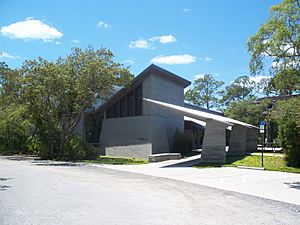
New Smyrna Beach is known as one of "America's Top Small Cities for the Arts." It is home to:
- The Atlantic Center for the Arts: This is a place where artists can live and work, and it also offers educational programs.
- The Harris House
- The Little Theatre
- Arts on Douglas: A gallery that shows fine arts.
A fun fact about New Smyrna Beach is that roosters roam freely on Flagler Avenue, the city's main street. People believe they are there because some locals let them go, as only hens are allowed for personal use.
The New Smyrna Speedway is a half-mile paved racetrack that opened in 1967. It hosts several racing events, including the ARCA Menards Series East and the NASCAR Whelen Modified Tour.
Shark Encounters
According to the International Shark Attack File at the University of Florida, Volusia County has had more confirmed shark bites than any other place in the world. Experts even call the county the "world's shark-bite capital." In 2008, the town had a record 24 shark bites.
While shark bites happen, very few of them are deadly. For example, in September 2016, three different surfers were bitten within a few hours at the same beach. In July 2024, two men and a 14-year-old boy were bitten in three separate attacks in less than one week.
Notable People from New Smyrna Beach
Many interesting people have connections to New Smyrna Beach:
- Joseph Barbara, an actor known for the TV show Another World
- Emory L. Bennett, a U.S. Army soldier who won the Medal of Honor in the Korean War
- The Beu Sisters, music artists
- Joyce Cusack, a Florida politician
- Suzanne Kosmas, a former U.S. Representative
- Walter M. Miller, Jr., author of A Canticle for Liebowitz
- Cory Mills, a U.S. Representative
- Jack Mitchell, a famous photographer
- Preston Pardus, a stock car racing driver
- Jim Parsley, a stock car racing driver
- Jacob Winchester, a composer and writer
Athletes
- Dallas Baker, a professional football player and coach
- Perry Baker, a professional rugby player for the U.S. national team
- Laura Brown, a former professional golfer
- Wes Chandler, a professional football player in the NFL
- Eric Geiselman, a professional surfer
- Chris Isaac, a former quarterback in the CFL
- Raheem Mostert, a football running back for the Miami Dolphins
- Duffy Waldorf, a professional golfer
Gallery
See also
 In Spanish: New Smyrna Beach para niños
In Spanish: New Smyrna Beach para niños


